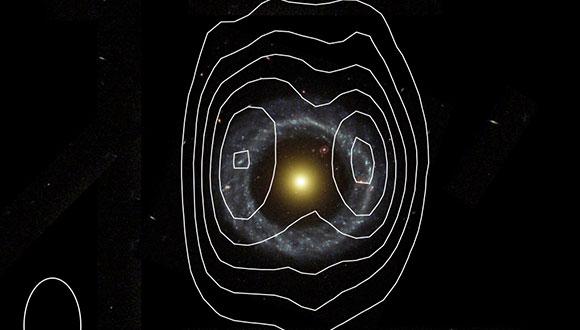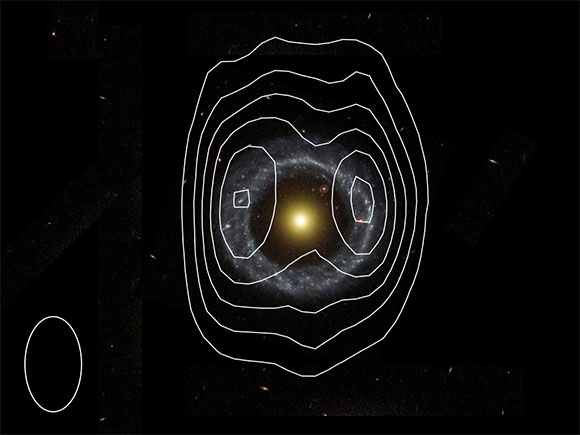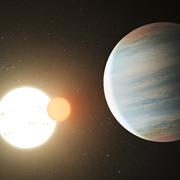International team discovers a much larger hydrogen ring around the most perfect ring galaxy
published in the ASTRON/JIVE Daily Image web site on July 25, 2013
HI in HO: a myth debunked
Submitter: Tom Oosterloo
One of the gems of the sky is Hoag's Object (HO). Discovered by Art Hoag in 1950 as a very unusual galaxy, its full beauty, as a red galaxy surrounded by a peculiar very blue ring, really became apparent with the Hubble image (shown above) taken 52 years later. The peculiar beauty of HO inspired several people to peculiar explanations of this peculiar object. For example, Hoag himself suggested that 'his' object could be a case of gravitational lensing (it would be a perfect Einstein ring), but later observations ruled out this hypothesis because it would require the central object to be at least 100 times more massive than any other galaxy.
So is HO a strange object or are appearances deceiving? One way to explore the nature of a galaxy is to study the properties of the neutral hydrogen (HI) in and around it. HI has a long memory: the timescales on which the HI structures around a galaxy change are long and the HI can be used as a tracer of things that happened long ago. This is not a new idea and Noah Brosch (Tel Aviv University) used the WSRT in 1982 to try to detect the HI in HO in an attempt to unravel the nature of HO. Unfortunately, in 1982 the WSRT was not sensitive enough to detect the HI and the mystery of the nature and origin of HO was not solved.
Napoleon has told us that "la victoire appartient aux plus perse've'rants", so 30 years later, Brosch did a new attempt with, obviously, a much improved WSRT. And indeed, in the new observations the HI in HO was clearly detected. One of the key results of the new observations is that, although HO looks peculiar in the optical, from the HI point of view HO is a fairly normal galaxy.
The data show that the nice blue ring is very gas rich while the red central galaxy has no gas. The fact that the HI seems to peak at the E and W side of the ring is an observational effect due to the elongated shape of the WSRT beam at these declinations (bottom left). The HI extends slightly beyond the blue ring; in these outer regions the HI ring warps slightly from the plane of the inner ring. The HI in the ring of HO shows no signs of any recent (i.e. less than 1 Gyr) event that could have created the blue ring, consistent with earlier studies of the stellar population in the ring (Finkelman). However, there are some shreds of HI floating around, far away from HO, that may have to do something with the origin of the ring, many Gyr ago.
All these HI characteristics are observed in many early-type galaxies and the conclusion of the WSRT observations is that HO may look special, but it really isn't.
The observations and their discussion are written in the paper 'HI in HO: Hoag's Object revisited' by Brosch, Finkelman, Oosterloo, Jozsa and Moiseev that has been accepted for publication in the Monthly Notices of the Royal Astronomical Society. A copy of this paper can be found at the Cornell University Library.
The figure shows the HST image of HO with the HI intensity contours drawn on top.
(Click on image to enlarge)






